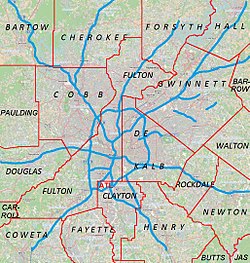Winnona Park Historic District | |
| Location | Bounded by College (N), Columbia (E), Mimosa/City Limits (S), Candler (W) Decatur, Georgia |
|---|---|
| Coordinates | 33°46′00″N84°17′16″W / 33.766626°N 84.28786°W |
| Built | 1923 |
| Architect | Leila Ross Wilburn |
| Architectural style | Late 19th and 20th Century Revivals, Late 19th and Early 20th Century American Movements |
| NRHP reference No. | 02000565 |
| Added to NRHP | May 30, 2002 |
Winnona Park is a historic area in the southeast corner of the Atlanta, Georgia suburb of Decatur. It is listed as a historic district on the National Register of Historic Places, [1] but it is not one of the City of Decatur's locally designated historic districts.
Contents
Winnona Park is located south of downtown Decatur; west of the Village of Avondale Estates, Georgia and the Forest Hills subdivision; and east of Decatur's Oakhurst community. It primarily consists of residences, but is also known as the home of Columbia Theological Seminary. Its rough boundaries are Mimosa Drive and the Decatur city limits on the south; East College Avenue and the railroad tracks on the north; South Candler Street on the west; and South Columbia Avenue on the east. In addition, the commercial buildings on the east side of South Columbia Ave. at East College Ave. have historically been part of this community. This commercial cluster historically housed the neighborhood pharmacy, gas station and barbershop.
The early families of Winnona Park also have historic links to Agnes Scott College, which adjoins Winnona Park on the northeast. However, the South Candler Street—Agnes Scott College Historic District is listed separately on the National Register of Historic Places. The City of Decatur has also designated South Candler Street - Agnes Scott College as a local historic district. Bounded by East College Ave., South McDonough St, South Candler St., East Hill St. and East Davis St., it is no longer considered part of Winnona Park.
In addition, the Forrest Hills community east of South Columbia Avenue is located in unincorporated DeKalb County, and is not considered part of Winnona Park. However, the City of Decatur announced in 2008 that they were considering the annexation of Forrest Hills.






